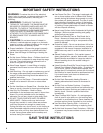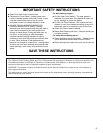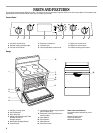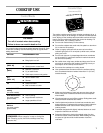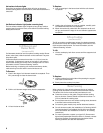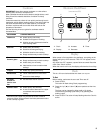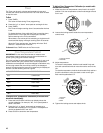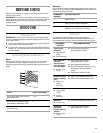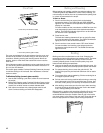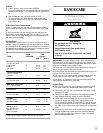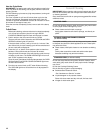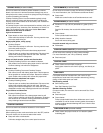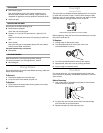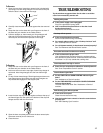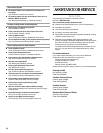
15
CERAMIC GLASS
(on some models)
Do not use steel wool, abrasive powder cleansers, chlorine
bleach, rust remover or ammonia because damage may occur.
Always wipe with a clean, wet cloth or sponge and dry thoroughly
to prevent streaking and staining.
Cooktop Polishing Creme is recommended regularly to help
prevent scratches, pitting and abrasions and to condition the
cooktop, and can be ordered as an accessory. See “Assistance
or Service” to order.
A Cooktop Scraper is also recommended for stubborn soils, and
can be ordered as an accessory. See “Assistance or Service” to
order. The Cooktop Scraper uses razor blades.
Store razor
blades out of the reach of children.
Light to moderate soil
■
Paper towels or clean damp sponge:
Clean while the cooktop is still warm. You may want to wear
oven mitts while doing so.
Sugary spills (jellies, candy, syrup)
■
Cooktop Scraper:
Clean while the cooktop is still warm. You may want to wear
oven mitts while doing so.
■
Cooktop Polishing Creme and clean damp paper towel:
Clean as soon as cooktop has cooled down. Rub creme into
surface with a damp paper towel or soft cloth. Continue
rubbing until white film disappears.
Heavy soil, dark streaks, specks and discoloration
■
Cooktop Polishing Creme or non-abrasive cleanser:
Rub product into soil with a damp paper towel or soft cloth.
Continue rubbing until white film disappears.
Burned-on soil
■
Cooktop Polishing Creme and Cooktop Scraper:
Rub creme into soil with damp paper towel. Hold scraper as
flat as possible on surface and scrape. Repeat for stubborn
spots. Polish entire cooktop with creme and paper towel.
Metal marks from aluminum and copper
■
Cooktop Polishing Creme:
Clean as soon as cooktop has cooled down. Rub creme into
surface with a damp paper towel or soft cloth. Continue
rubbing until white film disappears. The marks will not totally
disappear but after many cleanings become less noticeable.
Tiny scratches and abrasions
■
Cooktop Polishing Creme:
Rub creme into surface with a damp paper towel or soft
cloth. Continue rubbing until white film disappears. Scratches
and abrasions do not affect cooking performance and after
many cleanings become less noticeable.
COOKTOP CONTROLS
Do not use steel wool, abrasive cleansers or oven cleaner.
Do not soak knobs.
When replacing knobs, make sure knobs are in the OFF position.
On some models, do not remove seals under knobs.
■
Soap and water or dishwasher:
Pull knobs straight away from control panel to remove.
COIL ELEMENTS
(on some models)
Do not clean or immerse in water. Soil will burn off when hot.
For more information, see “Coil Elements and Burner Bowls”.
■
Damp cloth:
Make sure control knobs are off and elements are cool.
BURNER BOWLS
(on some models)
■
Solution of
¹₂
cup (125 mL) ammonia to 1 gallon (3.75 L)
water:
Soak for 20 minutes, then scrub with stainless steel wool
pad.
■
Oven cleaner:
Follow product label instructions.
■
Mildly abrasive cleanser:
Scrub with wet scouring pad.
Porcelain enamel only, not chrome
■
Dishwasher
SURFACE UNDER COOKTOP
(on some models)
Do not remove the cooktop to avoid product damage.
For more information, see “Lift-up Cooktop” section.
■
Steel wool pad
CONTROL PANEL
■
Glass cleaner and soft cloth or sponge:
Apply glass cleaner to soft cloth or sponge, not directly on
panel.
OVEN CAVITY
Food spills should be cleaned when oven cools. At high
temperatures, foods react with porcelain and staining, etching,
pitting or faint white spots can result.
Self-Cleaning models
■
Self-Cleaning cycle:
See “Self-Cleaning Cycle” first.
Standard-Cleaning models
On some models, the oven door can be removed. See “Oven
Door” first.
■
Steel wool pad
■
Oven cleaner:
Follow product label instructions. Make sure room is well-
ventilated. Do not let cleaner contact gasket, thermostat or
exterior surfaces because damage will occur. Line the floor
with newspaper.
OVEN DOOR GLASS
(on some models)
■
Glass cleaner and paper towels or non-abrasive plastic
scrubbing pad



